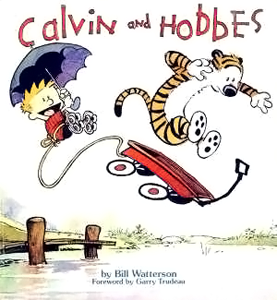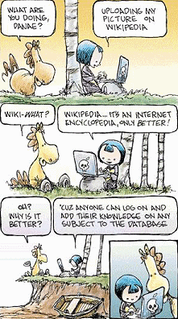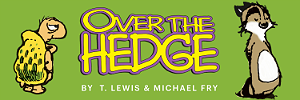William Boyd Watterson II is a retired American cartoonist and the author of the comic strip Calvin and Hobbes, which was syndicated from 1985 to 1995. Watterson stopped drawing Calvin and Hobbes at the end of 1995, with a short statement to newspaper editors and his readers that he felt he had achieved all he could in the medium. Watterson is known for his negative views on comic syndication and licensing, his efforts to expand and elevate the newspaper comic as an art form, and his move back into private life after he stopped drawing Calvin and Hobbes. Watterson was born in Washington, D.C., and grew up in Chagrin Falls, Ohio. The suburban Midwestern United States setting of Ohio was part of the inspiration for Calvin and Hobbes.

A comic strip is a sequence of drawings, often cartoons, arranged in interrelated panels to display brief humor or form a narrative, often serialized, with text in balloons and captions. Traditionally, throughout the 20th and into the 21st century, these have been published in newspapers and magazines, with daily horizontal strips printed in black-and-white in newspapers, while Sunday papers offered longer sequences in special color comics sections. With the advent of the internet, online comic strips began to appear as webcomics.

Calvin and Hobbes is a daily American comic strip created by cartoonist Bill Watterson that was syndicated from November 18, 1985, to December 31, 1995. Commonly cited as "the last great newspaper comic", Calvin and Hobbes has enjoyed broad and enduring popularity, influence, and academic and philosophical interest.

Monty is an American comic strip created, written and illustrated by cartoonist Jim Meddick. The strip began as Robotman starting February 18, 1985. The title changed to Monty in 2001.

Achewood is a webcomic created by Chris Onstad in 2001. It portrays the lives of a group of anthropomorphic stuffed toys, robots, and pets. Many of the characters live together in the home of their owner, Chris, at the fictional address of 62 Achewood Court. The events of the strip mostly take place in, and around the house, as well as around the town of Achewood, the fictional suburb which gives its name to the comic.

Pearls Before Swine is an American comic strip written and illustrated by Stephan Pastis. The series began on December 31, 2001. It chronicles the daily lives of an ensemble cast of suburban anthropomorphic animals: Pig, Rat, Zebra, Goat, and a fraternity of crocodiles, as well as a number of supporting characters, one of whom is Pastis himself. Each character represents an aspect of Pastis's personality and worldview. The daily and Sunday comic strip is distributed by Andrews McMeel Syndication.

Stephan Thomas Pastis is an American cartoonist and former lawyer who is the creator of the comic strip Pearls Before Swine. He also writes children's chapter books, commencing with the release of Timmy Failure: Mistakes Were Made. The seventh book, It's the End When I Say It's the End, debuted at #4 on The New York Times Best Seller list for Children's Middle Grade Books.

Questionable Content is a slice-of-life webcomic written and illustrated by Jeph Jacques. It was launched in August 2003 and as of April 2021 reached its 4,500th comic. The plot originally centered on Marten Reed, an indie rock fan; his anthropomorphized personal computer Pintsize; his roommate, Faye Whitaker; their mutual friend, Dora Bianchi; and their neighbor Hannelore Ellicott-Chatham. However, over time a supporting cast of characters has grown to include employees of the local coffee shop, neighbors, and androids. QC's storytelling style combines romantic melodrama, situational comedy, and sexual humor, while considering questions of relationships, sexuality, dealing with emotional trauma, and artificial intelligence and futurism.

Rex Morgan, M.D. is an American soap opera comic strip, created May 10, 1948 by psychiatrist Dr. Nicholas P. Dallis under the pseudonym Dal Curtis.

Non Sequitur is a comic strip created by Wiley Miller starting February 16, 1992 and syndicated by Andrews McMeel Syndication to over 700 newspapers. It is also published on gocomics.com and distributed via email.
Spaceman Spiff is a science fiction hero within the Calvin and Hobbes comic strip, which Bill Watterson wrote and illustrated from 1985 to 1995.
Frazz is a syndicated comic strip by Jef Mallett about school custodian Edwin "Frazz" Frazier and the school and students where he works. The strip debuted on 2 April 2001, and as of 2019, appears in over 250 newspapers and is read by tens of thousands online each day.

Dana Claire Simpson is an American cartoonist, best known as the creator of the syndicated comic strip Phoebe and Her Unicorn, as well as the long-running webcomic Ozy and Millie. Other works created by Simpson include the political commentary cartoon I Drew This and the alternate reality drama comic Raine Dog.
Least I Could Do (LICD) is a humor webcomic by Ryan Sohmer and Lar deSouza. The strip debuted on February 10, 2003. Past artists for the strip include John Horsley from y2cl, who dropped out before the strip launched, Trevor Adams, who was on board for about six months, then Chad W. M. Porter, who drew the strip for two years.

Over the Hedge is an American syndicated comic strip, written by Michael Fry, and drawn by T. Lewis. It tells the story of a raccoon, a turtle, a squirrel and their friends who come to terms with their woodlands being taken over by suburbia trying to survive the increasing flow of humanity and technology, while becoming enticed by it at the same time. The strip debuted on June 12, 1995. The comics were adapted in May 2006 into an animated film of the same name by DreamWorks Animation.
Bill Watterson's comic strip Calvin and Hobbes features a wide range of secondary characters. These range from his fellow students at school to monsters and aliens from Calvin's vivid imagination.
Liō is a daily comic strip created by American artist Mark Tatulli and distributed by Universal Press Syndicate/Universal Uclick/Andrews McMeel Syndication since May 15, 2006. As a pantomime strip, it has an international appeal. In 2008, the strip brought Tatulli a National Cartoonists Society Newspaper Comic Strip Award.

Chris Eliopoulos is an American cartoonist and letterer of comic books.
Cul de Sac is an American comic strip created by Richard Thompson. It was distributed by Universal Press Syndicate/Universal Uclick to 150 worldwide newspapers from 2004 to 2012.

Teaching with Calvin and Hobbes is an American children's textbook published in 1993. As a rare piece of officially licensed Calvin and Hobbes merchandise, it is a highly valued collectible.












